Fashion Designs Uning the Principal and Elements of Design Projects
- Clothing Patterns 101
- Elements of Pattern
Bones Elements of Clothing Blueprint
If you've always wanted to dabble in clothing design merely thought you didn't have the skill or the talent, I'yard here to tell you:
You can practise it!
If you sew your ain clothes from commercial patterns y'all buy at the fabric shop,you already brand design decisions regarding fashion, color, cloth, and details.You make similar decisions when you shop, choosing the styles that have the details you want (that is, if you can find them!)
You tin blueprint your own apparel using the same mode sense you apply when you sew or when yous shop - and you lot have total control over the results!
Elements of Design
The design details you lot'd use to distinguish your style include;
- the shape of the neck and/or neckband
- the length, shape and fullness of sleeves (with or without cuffs)
- the shape, length, and fullness of a skirt
- the length, shape and fullness of a pinnacle or blouse.
By combining these elements in a "mix and match" fashion, y'all'll create an endless multifariousness of styles - try a shawl collar with short sleeves, or bell sleeves and a Five-cervix elevation. These are simple variations on a basic blouse or top!
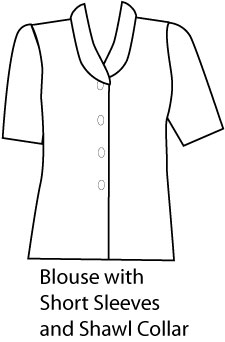
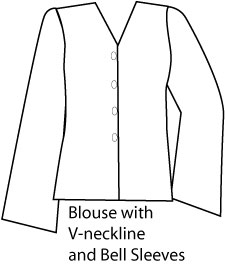
Darts and shaping seams can likewise be used equally design elements – princess seams and shoulder or hip yokes are commonly used design details that as well give the garment shape and fit.
Pleats and gathers add fullness and motion. A slim cut skims the body and is more than tailored. By "mixing and matching" various design elements, you can come up with an almost endless assortment of styles.
Ease is the corporeality of extra fabric allowed for move and/or style in a garment.Fitting ease (wearing ease) is the minimum amount of room needed for condolement and movement, usually ane – 1 ½" more than the body measurement.Fashion ease (design ease) is additional ease added to achieve the desired style (such as a full skirt or a full sleeve, or an oversized silhouette).
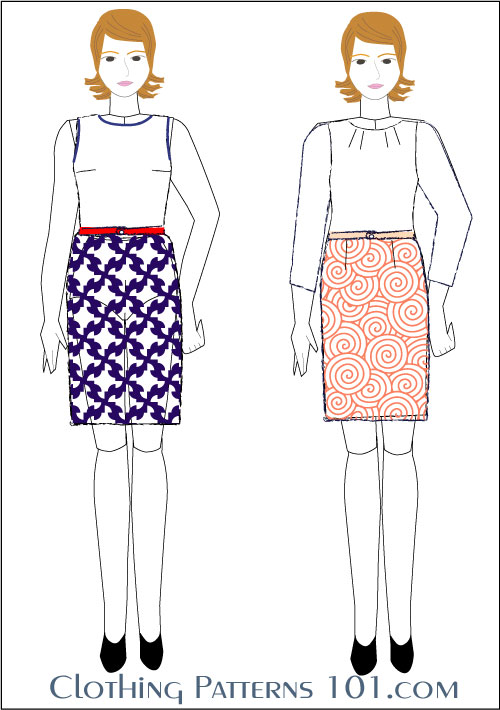
Even the most bones wearing apparel can have a multifariousness of looks, depending upon the style details you choose.
For example, both of the dresses at left have the same silhouette - simple, fitted styles with a natural waistline.
But thedifferent colors, prints, and position of the bodice darts (side darts vs. cervix darts) assistance create two entirely different looks. 1 has sleeves, one is sleeveless with dissimilarity binding - you could add or remove sleeves on either dress for yet some other new wait.
Add together flared skirts, total sleeves, or collars and you have an endless variety of fashions.
Shorten the torso into a collection of tops and blouses and pair with skirts or pants - even more style options!
Simple elements, grouped together in varying combinations, are what clothing blueprint is all virtually.
Finding Your Inspiration
To discover inspiration for your designs, wait to the past, to other cultures, or just to the latest fashion magazines.
Don't re-create direct from another designer, especially if you plan on selling your creations. But focus on a detail that you love, and incorporate that into your blueprint. It can be something as simple equally the shape of a neckline, the mantle of the bodice, the flare of the brim - anything that catches your center (information technology's bound to catch everyone else'southward heart in your garment, likewise!).
I love historic costume, only post-obit a garment from the by feels also "costume-y" to me. I'll use the sleeve and neckline, or shape of the skirt, as inspiration for my own design.
I also love indigenous clothing, but again, want to avoid looking similar I'm wearing a costume. Stitching or other decorative details tin easily be incorporated into a simple top or dress.
For example, this is a 1920's 2-slice wearing apparel that inspires me. I like the wide cervix and tapered sleeves, merely I particularly like the pleats at the left side and the low-slung belt.

This is a kurta, which is a traditional men's tunic from India. It has a stand collar and regular shirt sleeves, but it also has the side pleats I like - and the asymmetrical hem is very mod.
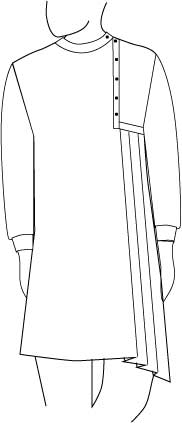
Using the 2 styles above, I created two different tunics utilizing elements from BOTH styles.
The one on the left refers mostly to the men's kurta, but has the more feminine neckline and tapered sleeves taken from the 1920'southward dress.
The one on the right references the dress, it'due south been shortened to tunic length with the asymmetrical hem of the kurta. This necessitates raising the belt to the high hip, too.
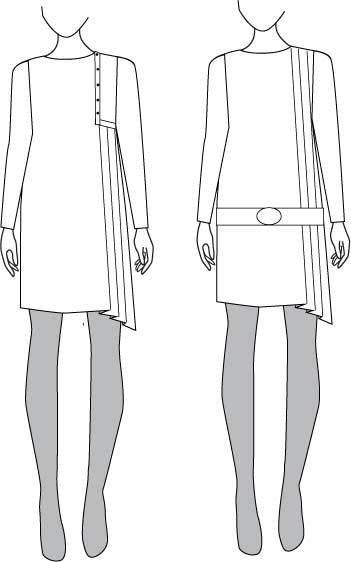
Neither of the tunics I designed are copies, but both retain elements from the historic and ethnic originals.
How to Go Started
So, how to you commencement designing your own dress?
Just start sketching! Browse through magazines, make a quick sketch when you see a glory wearing something you honey, or brand a note of a detail every bit you're watching a TV show or movie.
And so start putting those details together into a garment!
There volition exist a lot of trial and error - some design elements work well together, some don't - and don't try to put ALL your favorite details into i garment. It's overwhelming and you'll lose focus.
But all you accept to practise is sketch, sketch, sketch - keep trying different combinations until you find what you really like.
To aid with your sketches, I have adult a sketch book, with figure templates (chosen "croquis") that volition make it much easier to describe your styles with proper proportion, and describe movement. Creating a realistic sketch of your idea volition assistance you lot visualize the mode more fully.
The sketch book is available with misses or plus size croquis, and in a full-sail size (viii ane/2" ten 11") or a smaller, purse size book
.
Click on the images, below, to go to the item in Amazon.As an Amazon Acquaintance I earn from qualifying purchases. This helps to keep this site free for your use. You are gratuitous to search Amazon for these or other similar items without using the affiliate links on this folio.


Modest Book

Small Book

And add color!! Color can brand or break a design. And achange of color - or colour combinations -can create a whole new await for the same silhouette!
How can y'all get a grip on color? With coloring books! (yes, Really!!).
These fashion-inspired books, below, are a great showtime. Just grab some color pencils and get! Information technology's only paper. You tin't brand a fault! Effort combinations that you think you'd never actually wear. Y'all'll be surprised at what works and what doesn't - and how much departure a change of color tin make to any garment.
Click on the images, below, to go to the particular in Amazon.As an Amazon Acquaintance I earn from qualifying purchases. This helps to keep this site free for your utilise. Yous are complimentary to search Amazon for these or other like items without using the affiliate links on this page.
What's the Next Stride?
Step-past-Step: Making and Fitting Your Block
- Make Apparel that Fit You lot Perfectly
- Using Plumbing equipment Patterns
- A Beginner's Guide to Drafting a Dress Block
- Plumbing fixtures the Bodice Pattern
- Full Bosom Adjustment
- Plumbing fixtures the Sleeve Pattern
- Plumbing fixtures the Skirt Pattern
- Making Your Personal Pattern Block
- Making a Women's Blouse Block
- Plumbing equipment the Pants - Initial Fitting
- Plumbing equipment the Pants - Terminal Fitting
- A Beginner's Guide to Drafting a Pant Block
- The Importance of Sewing Darts
- Pattern Grading
Return to Wearable Patterns 101 Dwelling Page
0 Response to "Fashion Designs Uning the Principal and Elements of Design Projects"
Post a Comment